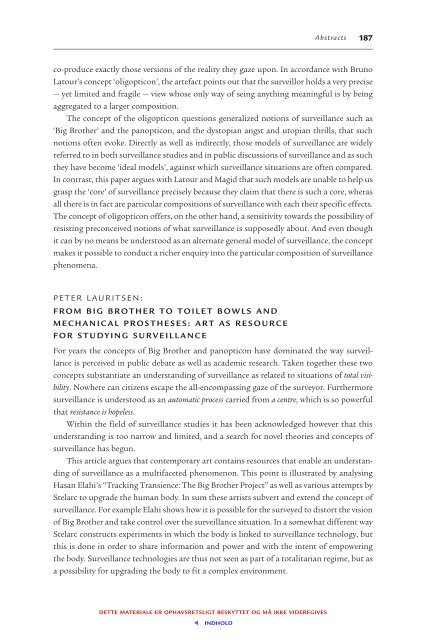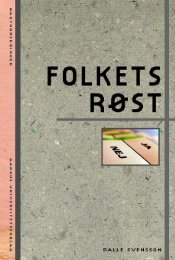K&K. Kultur og Klasse · Nr. 110 · Årgang 2010 - Aarhus University ...
K&K. Kultur og Klasse · Nr. 110 · Årgang 2010 - Aarhus University ...
K&K. Kultur og Klasse · Nr. 110 · Årgang 2010 - Aarhus University ...
You also want an ePaper? Increase the reach of your titles
YUMPU automatically turns print PDFs into web optimized ePapers that Google loves.
DETTE MATERIALE ER OPHAVSRETSLIGT BESKYTTET OG MÅ IKKE VIDEREGIVES<br />
INDHOLD<br />
Abstracts<br />
co-produce exactly those versions of the reality they gaze upon. In accordance with Bruno<br />
Latour’s concept ‘oligopticon’, the artefact points out that the surveillor holds a very precise<br />
— yet limited and fragile — view whose only way of seing anything meaningful is by being<br />
aggregated to a larger composition.<br />
The concept of the oligopticon questions generalized notions of surveillance such as<br />
‘Big Brother’ and the panopticon, and the dystopian angst and utopian thrills, that such<br />
notions often evoke. Directly as well as indirectly, those models of surveillance are widely<br />
referred to in both surveillance studies and in public discussions of surveillance and as such<br />
they have become ‘ideal models’, against which surveillance situations are often compared.<br />
In contrast, this paper argues with Latour and Magid that such models are unable to help us<br />
grasp the ‘core’ of surveillance precisely because they claim that there is such a core, wheras<br />
all there is in fact are particular compositions of surveillance with each their specific effects.<br />
The concept of oligopticon offers, on the other hand, a sensitivity towards the possibility of<br />
resisting preconceived notions of what surveillance is supposedly about. And even though<br />
it can by no means be understood as an alternate general model of surveillance, the concept<br />
makes it possible to conduct a richer enquiry into the particular composition of surveillance<br />
phenomena.<br />
PETER LAURITSEN:<br />
FROM BIG BROTHER TO TOILET BOWLS AND<br />
MECHANICAL PROSTHESES: ART AS RESOURCE<br />
FOR STUDYING SURVEILLANCE<br />
For years the concepts of Big Brother and panopticon have dominated the way surveillance<br />
is perceived in public debate as well as academic research. Taken t<strong>og</strong>ether these two<br />
concepts substantiate an understanding of surveillance as related to situations of total visibility.<br />
Nowhere can citizens escape the all-encompassing gaze of the surveyor. Furthermore<br />
surveillance is understood as an automatic process carried from a centre, which is so powerful<br />
that resistance is hopeless.<br />
Within the field of surveillance studies it has been acknowledged however that this<br />
understanding is too narrow and limited, and a search for novel theories and concepts of<br />
surveillance has begun.<br />
This article argues that contemporary art contains resources that enable an understanding<br />
of surveillance as a multifaceted phenomenon. This point is illustrated by analysing<br />
Hasan Elahi’s “Tracking Transience: The Big Brother Project” as well as various attempts by<br />
Stelarc to upgrade the human body. In sum these artists subvert and extend the concept of<br />
surveillance. For example Elahi shows how it is possible for the surveyed to distort the vision<br />
of Big Brother and take control over the surveillance situation. In a somewhat different way<br />
Stelarc constructs experiments in which the body is linked to surveillance tech nol<strong>og</strong>y, but<br />
this is done in order to share information and power and with the intent of empowering<br />
the body. Surveillance tech nol<strong>og</strong>ies are thus not seen as part of a totalitarian regime, but as<br />
a possibility for upgrading the body to fit a complex environment.<br />
187








